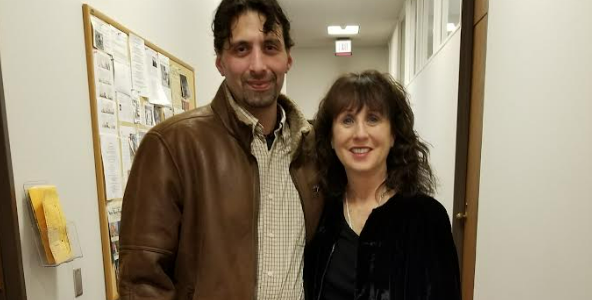10 RULES OF A PRISON ARTIST
NewsWill Sanchez February 19, 2024 admin

By Will “Topiltzin” Sanchez
(In Photograph Judge Nancy Margaret Russo 2020)
In 2003, I had to become a part of the judicial system, having been convicted of aggravated robbery sentenced to 5 years. Out early on Judicial release, but the probation length is usually twice the prison sentence. I understand the difficulties of recidivism, it’s not easy to break out of the system cycle without a plan already in place once released. Since then, I have done my best to seek redemption for a tragic night, always in search of what is nearby. I was an artist and gallery owner before my sentence, having won an art contest the day before my terrible decision, the prize was $500, in art supplies, useless when in need of fast cash. But, during my incarceration was the first time as an artist I felt true expression in art, and my work was valued. It was personal, because the pieces became all custom work, a way to represent the feelings of a fellow inmate, so that they translate through art to whoever they’re sending it to. Economically, a prison artist’s footlocker is never empty, and usually, not many bother us too much nor tries a scam because, for some odd reason, they respect the talent.
- Art Supplies. Artists make use of what is available, and chances are very little is offered in the beginning of your stay in County jail. The incarcerated here are usually housed for months depending on their case, so supplies are few and far between. But a few items are at hand in most situations which are paper, envelopes, and a writing utensil. Your talent and these items are all that’s needed to start.
- With limited materials, I discovered what sells quick are cartoons characters drawn on the outside of an envelope. By chance, after a lot of soul searching, I was sending a letter out, and felt like dressing it up with art, sketching Mickey and Mini Mouse. A couple of other inmates noticed and approached asking if I’d do this for them with letters to their children. I did. My business was launched, in return I averaged 3 envelopes and for custom pieces 5 envelopes. I didn’t have the time to see where this endeavor took me, my stay was short term before I was moved on. With everyone having very little and people constantly changing, in County envelopes are currency, it’s best to keep things simple and consistent. If you happen to be going down the road to State Prison, the economy changes with both what it is based in and an increase in the exchange rate.
- You have an open field and, quite literally, a captured market. Art crosses over any barriers or obstacles because what you are doing most of the time is expressing your client’s emotional situation for them to send to their families. You’re both a greeting card manufacturer and if sentenced to more time then shipped on, a portrait artist.
- Once you are settled into your state bunk and new surroundings, which never happens, assess what supplies made the transfer with you from county. Here you can buy or have sent more diverse materials, such as drawing paper, colored and charcoal pencils. Although honestly, all that is needed is what we started with, paper and a pencil. What sells well and often are portraits, whether it be of the client themselves or a family member. It all gets sent as a present; your talent is their sincere gift to someone they care for. I suggest doing your best work with just pencil sketches, everyone is a custom piece, and the pricing was about 4 or 5 packs of cigarettes in 2003, higher if your work is more advanced. You will find out very quickly, as did I, that your customers appreciate your art, do not question a fair price, and they have very few options available, and that becomes exponentially if you’re a talented artist. I have personally witnessed an artist sell a pencil piece for 25 packs of Newport cigarettes, no hassle, his client paying over the course of months. The piece was without question a masterpiece; in fact, the artist would show it to other potential clients as an example of his work. Which I thought genius.
- Art Programs. It’s my advice you try to join a prison art program, the perks at my parent facility we got to order a more diverse variety of art materials, time set aside for art sessions at the recreation center multi-purpose room and an extra footlocker for art supplies, although it was kept on location. Also, you will be surrounded by the best artists with ideas for you that sometimes has served them for years.
- Advanced Art Supplies. Once you’re established, begin to explore the other materials or mediums offered. If you are a participant of the Prison Arts Program, you can purchase items from an arts supply catalog and can also keep the overflow of art materials in your regular inmate footlocker as non-contraband items. This is a need rather than luxury, you will discover there are quite a few people wanting to be in the arts program, so there is a waiting list and not all the inmates accepted can fit in the recreation hall “studio”.
- Public Art Sessions. Just as on the outside, people need to see your work so that they know you can produce unique pieces. Artists naturally have sessions, so simply plan to do them in an open area of the recreation hall or the yard. Whenever I could, I would work this way, otherwise your other option is to remain in the multi-purpose room.
- Tattoo Artists. You can also expand into designing for the local tattoo artists, they are usually artists themselves, but must focus on their guerilla tattooing, keeping the illegal machines running, and contraband materials in plenty supply. It’s a good niche market, which once again crosses every demographic, people must respect your work to wear it on their skin. Bonus, you get to design tattoos for your own body, at high discounts, if not for free exchange.
- Monthly Material Costs. Because of the situation, both financially and room capacity, it’s easy to keep your costs at a minimum. The facility provides most of the materials you need to start, progress, and succeed, choices provided the extraordinary amount of time. Always remember, basics always works because your talent is the true value.
- Time Based Bartering. There is no money exchanged in prison, nor is it permitted to barter, and we are not supposed to have it taken care of on the outside, but it happens, business is business. In some ways it is understandable, nobody wants to get in a situation where anyone owes another inmate. We artists must consider our process in a situation where everyone is counting down time, so accordingly, you’re limited in a timeline to produce work. At no time more than this does one count the days, hours and minutes that pass. That being the case, continually practice your craft, absorb the therapy it brings and learn patience.
Final notes, I very highly recommend against being locked up, it’s not fun, time slows to a halt, introspective is torturous and they treat you like you’re in prison. Yet, my experience has brought with it a game plan for the prison art hustle if it cannot be avoided. Which has also served me well on the outside to date.














